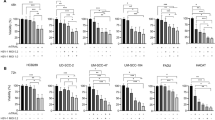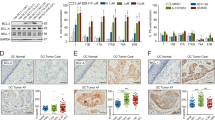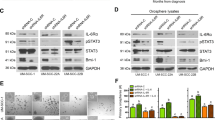Abstract
In this study, we investigated the in vitro and in vivo efficacy of Fas ligand (FasL) gene therapy for the treatment of head and neck cancer. Three head and neck squamous cell carcinoma (HNSCC) cell lines (SCC-1, SCC-12, and SCC-14a) were treated with the Fas agonist CH-11, a monoclonal antibody to the Fas receptor, or with a replication-incompetent adenovirus (AdGFPFasL) expressing a modified murine Fas ligand gene fused to green fluorescent protein (GFP). A replication-incompetent adenovirus containing the GFP gene alone was used as a control for viral transduction toxicity (AdGFP). Cell death was quantified using a tetrazolium-based (MTS) assay. Cells were analyzed by flow cytometry to determine the expression of adenoviral and Fas receptors on the surface of the cells. Our results showed that the head and neck cancer cell lines are resistant to cell death induction when treated with the anti-Fas monoclonal antibody CH-11. This resistance can be overcome with AdGFPFasL, which was able to induce cell death in all three cell lines. Apoptosis induction was demonstrated using Western blotting by evaluating poly(ADP-ribose) polymerase, and caspase 9 cleavages. In addition, intratumoral injections of AdGFPFasL into SCC-14a xenografts induced significant growth suppression of tumors, indicating that FasL gene therapy may provide a new efficient therapeutic modality for HNSCC that is worthy of a clinical trial.
This is a preview of subscription content, access via your institution
Access options
Subscribe to this journal
Receive 12 print issues and online access
$259.00 per year
only $21.58 per issue
Buy this article
- Purchase on Springer Link
- Instant access to full article PDF
Prices may be subject to local taxes which are calculated during checkout




Similar content being viewed by others
References
Ferris RL . Progress in head and neck cancer immunotherapy: can tolerance and immune suppression be reversed? ORL 2004; 66: 332–340.
Carvalho AL, Nishimoto IN, Califano JA, Kowalski LP . Trends in incidence and prognosis for head and neck cancer in the United States: a site-specific analysis of the SEER database. Int J Cancer 2005; 114: 806–816.
Norris JS, Norris KL, Holman DH, El-Zawahry A, Keane TE, Dong JY et al. The present and future for gene and viral therapy of directly accessible prostate and squamous cell cancers of the head and neck. Future Med 2004; 1: 1–9.
Suda T, Nagata S . Purification and characterization of the Fas-ligand that induces apoptosis. J Exp Med 1994; 3: 873–879.
Takahashi T, Tanaka M, Inazawa J, Abe T, Suda T, Nagata S et al. Human Fas ligand: gene structure, chromosomal location and species specificity. Int Immunol 1994; 10: 1567–1574.
Suda T, Takahashi T, Golstein P, Nagata S . Molecular cloning and expression of the Fas ligand, a novel member of the tumor necrosis factor family. Cell 1993; 6: 1169–1178.
Suda T, Hashimoto H, Tanaka M, Ochi T, Nagata S . Membrane Fas ligand kills human peripheral blood T lymphocytes, and soluble Fas ligand blocks the killing. J Exp Med 1997; 12: 2045–2050.
Gulbins E, Bissonnette R, Mahboubi A, Martin S, Nishioka W, Brunner T et al. FAS-induced apoptosis is mediated via a ceramideinitiated RAS signaling pathway. Immunity 1995; 4: 341–351.
Ambar BB, Frei K, Malipiero U, Morelli AE, Castro MG, Lowenstein PR et al. Treatment of experimental glioma by administration of adenoviral vectors expressing Fas ligand. Hum Gene Ther 1999; 10: 1641–1648.
Hedlund TE, Meech SJ, Srikanth S, Kraft AS, Miller GJ, Schaack JB et al. Adenovirus-mediated expression of Fas ligand induces apoptosis of human prostate cancer cells. Cell Death Differ 1999; 6: 175–182.
Zhang SW, Xiao SW, Liu CQ, Sun Y, Su X, Li DM et al. Treatment of head and neck squamous cell carcinoma by recombinant adenovirus-p53 combined with radiotherapy: a phase II clinical trial of 42 cases. Zhonghua Yi Xue Za Zhi 2003; 23: 2023–2028.
Hyer ML, Voelkel-Johnson C, Rubinchik S, Dong J, Norris JS . Intracellular Fas ligand expression causes Fas-mediated apoptosis in human prostate cancer cells resistant to monoclonal antibody-induced apoptosis. Mol Ther 2000; 2: 348–358.
Harrington KJ, Nutting CM, Pandha HS . Gene therapy for head and neck cancer. Cancer Metastasis Rev 2005; 1: 147–164.
Hyer ML, Sudarshan S, Schwartz DA, Hannun YA, Dong J-Y, Norris JS . Quantification and characterization of the bystander effect in prostate cancer cells following adenovirus-mediated FasL expression. Cancer Gene Ther 2003; 10: 330–339.
Rubinchik S, Norris JS, Dong JY . Construction, purification and characterization of adenovirus vectors expressing apoptosis-inducing transgenes. Methods Enzymol 2002; 346: 529–547.
Hyer ML, Sudarshan S, Kim Y, Reed JC, Dong JY, Schwartz DA et al. Downregulation of c-FLIP sensitizes DU145 prostate cancer cells to fas-mediated apoptosis. Cancer Biol Ther 2002; 1: 401–406.
Sudarshan S, Holman DH, Hyer ML, Norris JS . In vitro efficacy of Fas ligand gene therapy for the treatment of bladder cancer. Cancer Gene Ther 2005; 12: 12–18.
Bernier J, Cooper JS . Chemoradiation after surgery for high-risk head and neck cancer patients: how strong is the evidence? Oncologist 2005; 1: 215–224.
Day TA, Davis BK, Gillespie MB, Joe JK, Kibbey M, Martin-Harris B et al. Oral cancer treatment. Curr Treat Opt Oncol 2003; 1: 27–41.
Tong AW, Nemunaitis J, Su D, Zhang Y, Cunningham C, Senzer N et al. Intratumoral injection of INGN 241, a nonreplicating adenovector expressing the melanoma-differentiation associated gene-7 (mda-7/IL24): biologic outcome in advanced cancer patients. Mol Ther 2005; 11: 160–172.
Nemunaitis J, O’Brien J . Head and neck cancer: gene therapy approaches. Part II: genes delivered. Expert Opin Biol Ther 2002; 3: 311–324.
Maecker HL, Yun Z, Maecker HT, Giaccia AJ . Epigenetic changes in tumor Fas levels determine immune escape and response to therapy. Cancer Cell 2002; 2: 139–148.
Norris JS, Holman DH, Hyer ML, Bielawska A, El-Zawahry A, Chalfant C et al. Ceramide, ceramidase and FasL gene therapy in prostate cancer. In: El-Deiry WS (ed). Death Receptors in Cancer Therapy. Humana Press Inc.: Totowa, NJ, 2004, pp 323–338.
Acknowledgements
We would like to thank Janie Nelson for excellent secretarial assistance and the NIH funded viral vector core for production of AdGFPFasLTET and AdGFP. This research was supported by the NIH/NCI PO1 CA97132, HCC/DOD N6311601MD10004, and 1R24 CA82933.
Author information
Authors and Affiliations
Corresponding author
Rights and permissions
About this article
Cite this article
ElOjeimy, S., McKillop, J., El-Zawahry, A. et al. FasL gene therapy: a new therapeutic modality for head and neck cancer. Cancer Gene Ther 13, 739–745 (2006). https://doi.org/10.1038/sj.cgt.7700951
Received:
Revised:
Accepted:
Published:
Issue Date:
DOI: https://doi.org/10.1038/sj.cgt.7700951
Keywords
This article is cited by
-
Mononuclear phagocytes in head and neck squamous cell carcinoma
European Archives of Oto-Rhino-Laryngology (2010)
-
The Del1 deposition domain can immobilize 3α-hydroxysteroid dehydrogenase in the extracellular matrix without interfering with enzymatic activity
Bioprocess and Biosystems Engineering (2009)
-
Soluble factors released by activated cytotoxic T lymphocytes interfere with death receptor pathways in neuroblastoma
Cancer Immunology, Immunotherapy (2008)
-
Role of Acid Ceramidase in Resistance to FasL: Therapeutic Approaches Based on Acid Ceramidase Inhibitors and FasL Gene Therapy
Molecular Therapy (2007)
-
Combined therapeutic use of AdGFPFasL and small molecule inhibitors of ceramide metabolism in prostate and head and neck cancers: a status report
Cancer Gene Therapy (2006)



